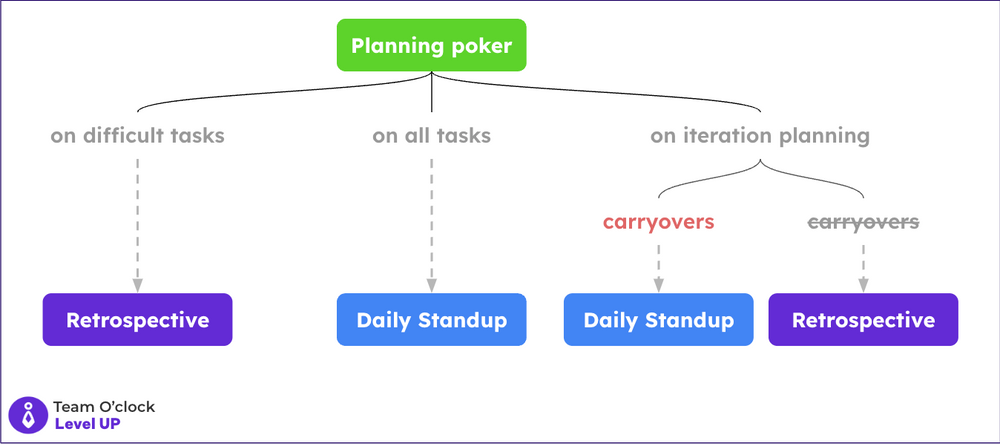
Boost Your Scrum Team's Success: Leveling Up Your Planning Poker and Adopting More Scrum Ceremonies

Since you're here, it means that you are already performing planning poker, or story pointing in some form. That's a great place to be! It means that you just started your agility journey. According to research on our user base, planning poker is step number one and you're there.
Let's start off with the planning poker session. The planning poker session is a collaborative estimation technique for teams. A session unfolds as shared in the list below:
The group focuses on a task they will be working on in the near future.
Through discussion, the team defines the scope of each task, clearing out any discrepancies and misunderstandings.
With the task scope and high-level specifications set, each team member votes on the effort needed.
The team follows up with a discussion of additional definitions if there is a big difference in members' votes and aligns on the effort.
The team starts over from point 2, with another task in focus.
Planning poker usually comes first with teams wanting to adopt scrum and agile. That's because this session is self-contained. There is no need for a commitment or building a recurring habit from the team to have a planning poker session.
Adopt more scrum ceremonies
As you grow accustomed to planning poker sessions, you and the whole team realize the alignment benefits. That's where you will be looking for more ways to improve as a team.
What follows are some suggestions for the next ceremony your team is mostly ready to adopt.
Ad-hoc planning poker sessions on very difficult tasks
If these ad-hoc planning poker sessions are on specific difficult tasks that need more analysis then you are already aligned as a team on the easier tasks.
In that case, you already cover the alignment a Daily Standup can offer in a different way. So suggesting and trying a Daily Standup you might feel disappointed as you will not see a direct impact on your day-to-day work.
What you and the team would benefit from is the Retrospective ceremony. The reasoning is that a team already aligned on daily work can easier discuss about further improvement in their processes. Since your team is already performing great on daily tasks, chances are you will deliver on any action items you come up with in a Retrospective.
You can use the impact of your first team Retrospective into building the habit for your next Retrospective! Don't rush to suggest your next Retrospective session by the time you write your action item. Be vocal when you deliver on your decided action item, sharing positive thoughts all around, and suggest your next Retrospective session at that time!
Ad-hoc planning poker sessions on all possible tasks
If this is your case, then your team is probably overwhelmed with work. You literally have a lot of tasks in your pipeline and minimal time to align. If you end up analyzing the same tasks again and again, that's another sign of misalignment.
In this case, a Daily Standup could help you move the needle forward. As a reminder, the Daily Standup is to share progress from the team to the team - not your Product Owner or Scrum Master. The more you talk about each individual's work in progress and their impediments, the more you will collaborate and reach alignment.
You can introduce the Daily Standup as a two-weeks experiment. Remember to keep it short and focus on the most important tasks of each team member - don't deep dive into each task. If a daily commitment is difficult, you can try out having a Daily Standup every second day, or two times in a work week.
Iteration planning & Planning poker estimation
This is the case where you and your team talk about your next work increments. Whether you plan in sprints or monthly iterations, the whole team gathers and discusses upcoming work. While you are at it you drop a short analysis and planning poker estimation on the tasks at hand.
From this point onward you can take two paths, depending on your iteration planning status:
The next iteration holds a lot of carryovers - work that should have been completed but it's not
. Despite all your efforts on analysis and story points, the team finds it hard to handle the workload of an iteration. This situation is indicating a misalignment problem in the team. For this situation, it would be best to start with a Daily Standup so that you all sync on daily progress and impediments. This way your team will start identifying the problem as iteration days pass by. You can also use the next iteration planning as a trigger to hold a Retrospective and discuss that previous period, your Daily Standup, and carryover issues.
Your iteration planning session has mostly new tasks, so few or no carryovers
. That's a great position to be! Your team is managing the work at hand smoothly. This also means that you have built strong relations and alignment as a team. Maybe it's a nice opportunity to introduce a Retrospective session so that you identify new areas you would like to dive into as a team. A futurespective Retrospective activity would help the team start talking about where you can be in the future.

If you want to explore more ways to improve your scrum game, check out the free Remote Scrum Guide. Information in there applies to both remote and in-office teams.

More articles to check

Assist your team's growth with our partnership program:








